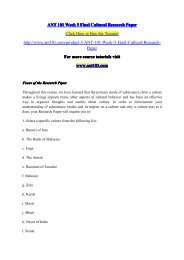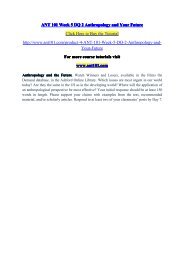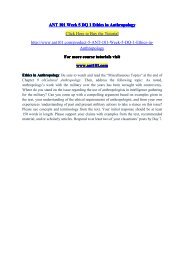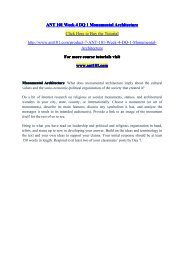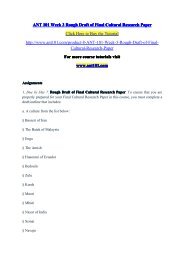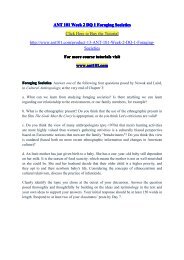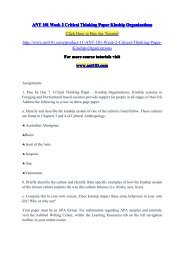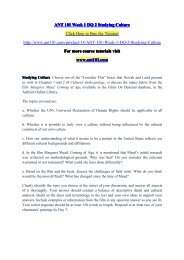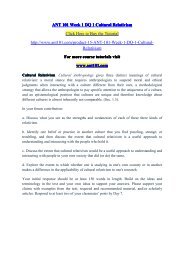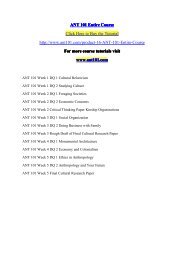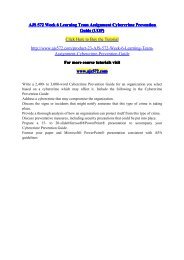ANT 101 Week 3 DQ 2 Doing Business with Family/ant101dotcom
For more course tutorials visit www.ant101.com Doing Business with Family. Nowak and Laird's Applying Anthropology 6.2 box, in Cultural Anthropology, proposes the following question: The familiar saying “never do business with family” advises against the practices used in many of the chiefdom societies discussed in this chapter. This old saying implies that doing business with family will create conflict, whereas chiefdom societies welcome and encourage such close-knit economic exchanges as a way of preventing conflict. In fact, in an interesting article on family businesses, Bertrand and Schoar comment on how cultures based on strong family ties can have a negative impact on economic development. The reasoning is that the more we are taught to count on our kinship and family ties, the less likely we are to trust those outside our family networks, which greatly prohibits the development of larger economic institutions.
For more course tutorials visit
www.ant101.com
Doing Business with Family. Nowak and Laird's Applying Anthropology 6.2 box, in Cultural Anthropology, proposes the following question:
The familiar saying “never do business with family” advises against the practices used in many of the chiefdom societies discussed in this chapter. This old saying implies that doing business with family will create conflict, whereas chiefdom societies welcome and encourage such close-knit economic exchanges as a way of preventing conflict. In fact, in an interesting article on family businesses, Bertrand and Schoar comment on how cultures based on strong family ties can have a negative impact on economic development. The reasoning is that the more we are taught to count on our kinship and family ties, the less likely we are to trust those outside our family networks, which greatly prohibits the development of larger economic institutions.
- No tags were found...
Create successful ePaper yourself
Turn your PDF publications into a flip-book with our unique Google optimized e-Paper software.
<strong>ANT</strong> <strong>101</strong> <strong>Week</strong> 3 <strong>DQ</strong> 2 <strong>Doing</strong> <strong>Business</strong> <strong>with</strong> <strong>Family</strong>Click Here to Buy the Tutorialhttp://www.ant<strong>101</strong>.com/product-9-<strong>ANT</strong>-<strong>101</strong>-<strong>Week</strong>-3-<strong>DQ</strong>-2-<strong>Doing</strong>-<strong>Business</strong><strong>with</strong>-<strong>Family</strong>For more course tutorials visitwww.ant<strong>101</strong>.com<strong>Doing</strong> <strong>Business</strong> <strong>with</strong> <strong>Family</strong>. Nowak and Laird's Applying Anthropology 6.2 box,in Cultural Anthropology, proposes the following question:The familiar saying “never do business <strong>with</strong> family” advises against the practices used inmany of the chiefdom societies discussed in this chapter. This old saying implies that doingbusiness <strong>with</strong> family will create conflict, whereas chiefdom societies welcome and encouragesuch close-knit economic exchanges as a way of preventing conflict. In fact, in an interestingarticle on family businesses, Bertrand and Schoar comment on how cultures based on strongfamily ties can have a negative impact on economic development. The reasoning is that themore we are taught to count on our kinship and family ties, the less likely we are to trustthose outside our family networks, which greatly prohibits the development of largereconomic institutions...Consider both examples and create an argument for or against mixing business <strong>with</strong> family.When responding to this question, be sure to engage in cross-cultural comparison, taking intoconsideration variation in subsistence systems, descent systems, mobility, and any otherfactors you consider pertinent. Draw examples from the ethnographic record, your ownexperience, and the experience of others <strong>with</strong> whom you are familiar. Your initial responseshould be at least 150 words in length. Please support your claims <strong>with</strong> examples from thetext, recommended material, and/or scholarly articles. Respond to at least two of yourclassmates’ posts by Day 7.



